Research Results
1. Artificial photosynthesis lets plants grow efficiently in total darkness
 A sharp increase in food and other agricultural products is needed in the coming decades to serve the growing world population, as well as to meet the increasing demand from increased prosperity. Land is limited, however, and so the main way to increase production is to increase crop yields per unit area and/or explore other production methods. In exploring the second alternative, scientists have improved the natural process of photosynthesis, by both growing plants more efficiently and doing it in the dark. Scientists have long experimented with artificial photosynthesis (AP), and they have already made it more efficient than the natural process. A research team, led by Jinkerson, University of California, Riverside, CA, USA, evaluated the technique on a variety of food-producing crops and bacteria, including yeast, green algae, mycelium, cowpea, and tomatoes, tobacco, rice, canola, and green peas.
A sharp increase in food and other agricultural products is needed in the coming decades to serve the growing world population, as well as to meet the increasing demand from increased prosperity. Land is limited, however, and so the main way to increase production is to increase crop yields per unit area and/or explore other production methods. In exploring the second alternative, scientists have improved the natural process of photosynthesis, by both growing plants more efficiently and doing it in the dark. Scientists have long experimented with artificial photosynthesis (AP), and they have already made it more efficient than the natural process. A research team, led by Jinkerson, University of California, Riverside, CA, USA, evaluated the technique on a variety of food-producing crops and bacteria, including yeast, green algae, mycelium, cowpea, and tomatoes, tobacco, rice, canola, and green peas.
Using AP approaches to food production could provide a paradigm shift in the way we feed people. The scientists have shown that all organisms can be grown in acetate in complete darkness and, in some cases, even more efficiently than in sunlight. “Using artificial photosynthesis methods to produce food could be a paradigm shift for how we feed humans,” said Robert Jinkerson, the study’s corresponding author. Combining the AP approach with existing photovoltaic systems could increase the efficiency of converting solar energy into food energy by about four times compared with biosynthesis, thereby reducing the amount of sun required. This technology reinvents the way food can be produced in a controlled environment.
Access the full paper at
https://www.nature.com/articles/s43016-022-00530-x
2. Discovery on exchange of nitrogen by microbes paves way for more sustainable crop cultivation methods
Early in the evolution of land plants, microbial symbiosis was essential for plants to colonise the land. Through such symbiosis, plants acquired nutrients and adapted to stress. “The development of new crop varieties or agricultural technologies, based on rebuilding and supporting native nitrogen-fixing endosymbionts, could dramatically change the way we grow crops,” says James White, who, along with his colleagues at 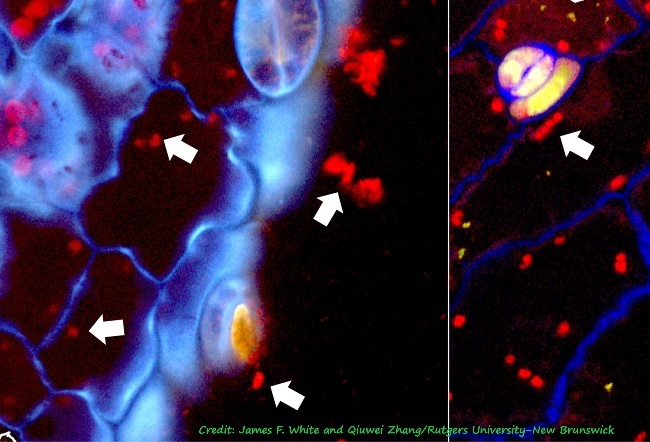 the Rutgers University-New Brunswick, studied bacteria in leaf and bract cells of more than 30 species in 18 families of seed plants, using light and confocal microscopy. The researchers discovered that bacteria in leaf cells can exchange nitrogen for plant sugars. This discovery shows how non-domesticated plants, such as wild plants or weed plants, grow in degraded soil without the need for additional nitrogen fertilizers.
the Rutgers University-New Brunswick, studied bacteria in leaf and bract cells of more than 30 species in 18 families of seed plants, using light and confocal microscopy. The researchers discovered that bacteria in leaf cells can exchange nitrogen for plant sugars. This discovery shows how non-domesticated plants, such as wild plants or weed plants, grow in degraded soil without the need for additional nitrogen fertilizers.
The highest efficiency of these puzzling nitrogen-transferring intramolecular bacteria was observed in the glandular triplets of dicotyledonous plants, such as hops and hemp. White says expanding our knowledge of how plants extract nitrogen from endosymbiotic bacteria in leaves could help growers find more efficient and sustainable ways to fertilize plants. “This study shows that it is possible to support the nitrogen-fixing activities of endosymbiotic bacteria in leaves by selecting plants to preserve native endospermia or by applying the microbiology to seedlings to restore the process of ‘nitrogen-fixing’ endosymbiosis”. The presence of endosymbioses that yield nitrate in plants could confer a reduced need for soil nitrogen and constitute increased nitrogen-use efficiency, even if the actual amount of nitrogen transferred to plant cells is small. More research is needed to evaluate the importance of nitrogen transfer within leaf and bract cells of plants.
Access the full paper at https://www.mdpi.com/2079-7737/11/6/876#
3. Both genetic and epigenetic control reduce vulnerability of crops to heat stress
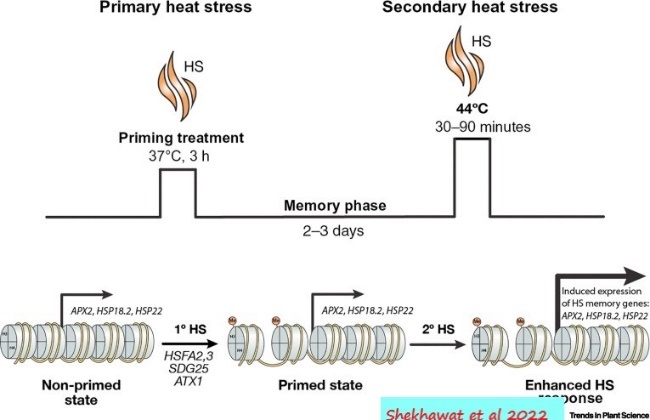 When heat waves hit, they do not just affect people; the plants we depend on for food are affected, too. This is because when temperatures are too high, some plant protections do not work as well, leaving them more vulnerable to pathogens and insects. Sheng Yang He and colleagues from Duke University, Durham, NC, USA, report that they have identified a specific protein in plant cells that explains why immunity fails at temperature increases (heat stress-HS). The researchers also found a way to reverse the loss and strengthen plants’ defences against heat, using a model species Arabidopsis thaliana. The CBP60g gene acts as a master switch controlling other genes, so anything that downregulates or “turns off” CBP60g means many other genes are turned off as well: they do not make the proteins that allow cells to function. If similar results occur in crops, it would be good news for food security in a warming world, said biologist He.
When heat waves hit, they do not just affect people; the plants we depend on for food are affected, too. This is because when temperatures are too high, some plant protections do not work as well, leaving them more vulnerable to pathogens and insects. Sheng Yang He and colleagues from Duke University, Durham, NC, USA, report that they have identified a specific protein in plant cells that explains why immunity fails at temperature increases (heat stress-HS). The researchers also found a way to reverse the loss and strengthen plants’ defences against heat, using a model species Arabidopsis thaliana. The CBP60g gene acts as a master switch controlling other genes, so anything that downregulates or “turns off” CBP60g means many other genes are turned off as well: they do not make the proteins that allow cells to function. If similar results occur in crops, it would be good news for food security in a warming world, said biologist He.
Kirti Shekhawat and colleagues at King Abdullah University of Science and Technology (KAUST), Thuwal, Saudi Arabia, examined recent advances in plant epigenetic regulation, with a view to highlight heat tolerance of microorganisms in plants (in addition to genetic control). Epigenetic changes in plants are shaped not only by mild stress but also by beneficial endophyte microorganisms. Heat stress (HS) affects plant growth and development, and thus reduces crop yield. The authors say that more research is needed to better understand HS and plant defences, and on the role of bacteria in HS. Such an understanding may help design approaches to improve crop yields and productivity in a warming environment.
For more, see https://phys.org/news/2022-06-climate-vulnerable-disease.html?utm_source=nwletter&utm_medium=email&utm_campaign=daily-nwletter
Access the full paper at https://www.nature.com/articles/s41586-022-04902-y
For more, see https://www.cell.com/trends/plant-science/fulltext/S1360-1385(22)00050-4?dgcid=raven_jbs_etoc_email
4. Understanding the molecular mechanism of copper in regulating broad-spectrum virus resistance in rice
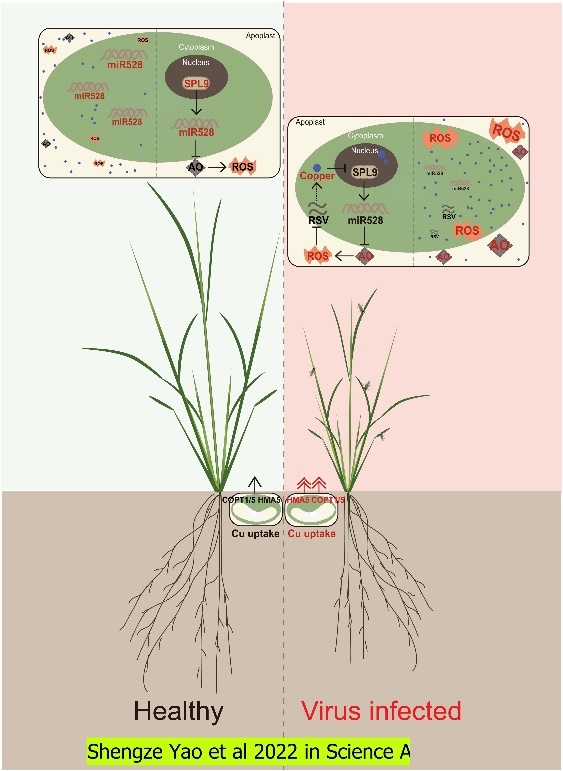 Copper is critical for a few plant growth development processes. We had earlier covered the importance of it for the seed dispersal of some plant species (See Copper makes seed pods explode in AgriTech 41). While some copper is essential for plant growth, too much or too little copper is an abiotic stressor that severely limits plant growth. Exogenous copper increases the antiviral defences of rice by blocking the active transcriptional regulation of some proteins, as in the application of copper-based Bordeaux mixture, for example. However, the mechanisms by which copper responds to virus invasion are unclear. Copper suppresses the transcriptional activation of miR528 by inhibiting the protein level of SPL9, thus alleviating miR528-mediated cleavage of AO transcripts to strengthen the antiviral response.
Copper is critical for a few plant growth development processes. We had earlier covered the importance of it for the seed dispersal of some plant species (See Copper makes seed pods explode in AgriTech 41). While some copper is essential for plant growth, too much or too little copper is an abiotic stressor that severely limits plant growth. Exogenous copper increases the antiviral defences of rice by blocking the active transcriptional regulation of some proteins, as in the application of copper-based Bordeaux mixture, for example. However, the mechanisms by which copper responds to virus invasion are unclear. Copper suppresses the transcriptional activation of miR528 by inhibiting the protein level of SPL9, thus alleviating miR528-mediated cleavage of AO transcripts to strengthen the antiviral response.
Shengze Yao and colleagues at the Peking University, Beijing, China, showed that SQUAMOSA promoter-binding–like protein 9 (SPL9)-mediated transcriptional activation of microRNA 528 (miR528) adds a previously unidentified regulatory layer to the established ARGONAUTE (AGO18)–miR528–Lascorbate oxidase (AO) antiviral defines. They have now shown that rice promotes copper accumulation in shoots by inducing copper transporter genes, including HMA5 and COPT, to counteract viral infection. Loss-of-function mutations in HMA5, COPT1, and COPT5 caused a significant reduction in copper accumulation and plant viral resistance because of the increased SPL9-mediated miR528 transcription. This study clarifies the molecular mechanisms and regulatory networks of copper homeostasis and the SPL9-miR528-AO antiviral pathway. Further research is needed to understand how these results can be applied in combating the viral disease of rice and other crops.
For more, see https://www.science.org/doi/10.1126/sciadv.abm0660
5.. Researchers identify genes that make strawberries resistant to fusarium wilt
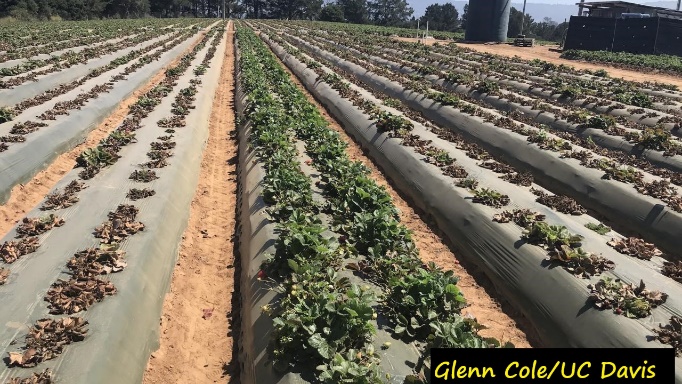 Fusarium wilt, a soilborne disease caused by Fusarium oxysporum f. sp. fragariae, poses a significant threat to strawberry (Fragaria × ananassa) production in many parts of the world. This disease was not always an issue, but when the disinfectant methyl bromide was phased out in 2005, things changed. Strawberry losses from fusarium wilt may now become less of a threat; researchers led by Steven Knapp,
Fusarium wilt, a soilborne disease caused by Fusarium oxysporum f. sp. fragariae, poses a significant threat to strawberry (Fragaria × ananassa) production in many parts of the world. This disease was not always an issue, but when the disinfectant methyl bromide was phased out in 2005, things changed. Strawberry losses from fusarium wilt may now become less of a threat; researchers led by Steven Knapp,
University of California, Davis, USA, have discovered resistance genes to the deadly disease from the soil. Strawberries are a staple in California, where about 1.8 billion pounds of nutritious fruit are grown each year, accounting for about 88% of the U.S. harvest. The gene discovery can prevent the fusarium wilt epidemic.
The researchers used genetic screening and DNA diagnostics to identify genes resistant to the major races of fusarium wilt. “Genes have been floating around in the genetic material of strawberries for thousands of years, but no one has worked to identify them,” Glenn Cole, a co-author, said. High-throughput genotyping assays for single nucleotide polymorphisms (SNPs) in linkage disequilibrium with (FW1-FW5 dominant alleles among loci) were developed to facilitate marker-assisted selection and accelerate the development of race 1-resistant cultivars. This study has laid the foundation for identifying the genes encoded by FW1-FW5, in addition to exploring the genetics of resistance to race 2 and other races of the pathogen, as a precaution to averting a fusarium wilt pandemic.
For more, see https://www.ucdavis.edu/food/news/researchers-identify-genes-making-strawberries-resistant-fusarium-wilt
Access the full paper at https://link.springer.com/article/10.1007/s00122-022-04102-2
6. Molecules that drive critical plant immunity identified
 Nucleotide-binding leucine-rich repeat (NLR) proteins are intracellular immune receptors that play a role in protecting plants and animals against diseases. Plant NLRs confer specific recognition of pathogen effectors to initiate effector-triggered immunity. Two studies by researchers from Germany, in collaboration with colleagues in China, have discovered natural cellular molecules that determine critical plant immune responses.
Nucleotide-binding leucine-rich repeat (NLR) proteins are intracellular immune receptors that play a role in protecting plants and animals against diseases. Plant NLRs confer specific recognition of pathogen effectors to initiate effector-triggered immunity. Two studies by researchers from Germany, in collaboration with colleagues in China, have discovered natural cellular molecules that determine critical plant immune responses.
Scientists led by Jijie Chai and Jane Parker from the Max Planck Institute for Plant Breeding Research in Cologne and the University of Cologne, Germany, have identified two classes of molecules and determined their modes of action in mediating immune responses inside plant cells. Their findings pave the way for the design of bioactive small molecules that could allow researchers and plant growers to manipulate—and thereby boost—plant resistance against pathogenic microbes.
The TIR immune receptors and EDS1 hub proteins exist in many important crop species, such as rice and wheat. Jijie Chai points out that “the identified TIR-catalysed small molecules could be employed as general and natural immunostimulants to control crop diseases.” Jane Parker further remarks that “knowing the biochemical modes of action of these small molecules opens a whole new chapter on plant immunity signalling and disease management.” The ADP-ribosylation reaction catalysed by TIR induces signalling molecules for plant immunity. Harnessing these insights may allow scientists and plant breeders to design molecules that make plants, including many important crop species, more resistant to disease.
For more, see https://www.technologynetworks.com/immunology/news/molecules-that-drive-critical-plant-immunity-identified-363501
Access the full paper (1, preprint) at https://www.science.org/doi/abs/10.1126/science.abq3297
Access the abstract (2) at https://www.science.org/doi/10.1126/science.abq8180
7. Gene fusion is an important mechanism to generate new genes in Oryza genomes
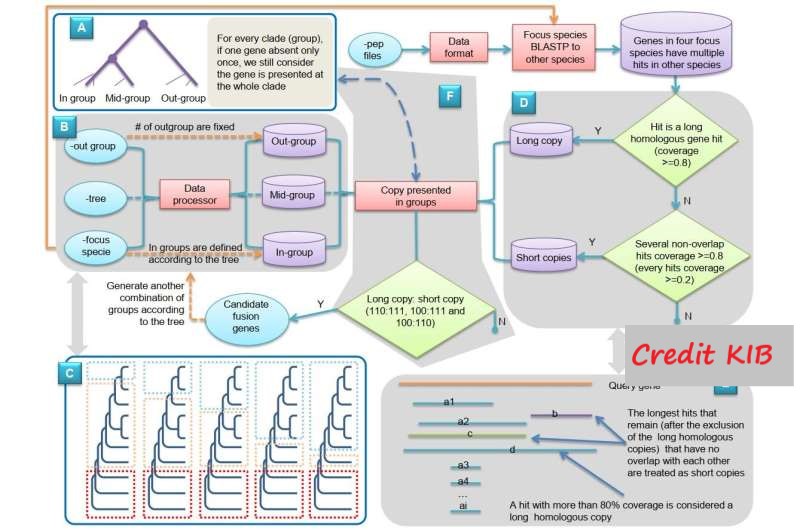 New genes are critical in the understanding of phenotypic evolution. They can be generated by several molecular mechanisms, including gene duplication, de novo evolution, and gene fusion. However, the exact role of gene fusion in generating new genes is still unknown. New evolutionary genes, fused from more than two parental genes, can escape the disadvantageous step of late evolution due to point mutations and be essential for understanding phenotypic evolution. Rod Wing of the University of Arizona, Tucson, AZ, USA, and his colleagues, also from Yunnan, Kunming, China, conducted genome-wide interrogations of four Oryza genomes by designing and implementing novel pipelines to detect fusion genes and detected 310 fusion genes across the four Oryza species.
New genes are critical in the understanding of phenotypic evolution. They can be generated by several molecular mechanisms, including gene duplication, de novo evolution, and gene fusion. However, the exact role of gene fusion in generating new genes is still unknown. New evolutionary genes, fused from more than two parental genes, can escape the disadvantageous step of late evolution due to point mutations and be essential for understanding phenotypic evolution. Rod Wing of the University of Arizona, Tucson, AZ, USA, and his colleagues, also from Yunnan, Kunming, China, conducted genome-wide interrogations of four Oryza genomes by designing and implementing novel pipelines to detect fusion genes and detected 310 fusion genes across the four Oryza species.
Initial estimates of fusion genes in Oryza average as high as 63 fusion genes per species per million years and are fixed at 16 fusion genes per species per million years per nucleotide polymorphism, called a population of genes. The researchers found that more than 44% of the fusion genes were expressed, and 90% of the gene pairs showed strong signals of pure selection, indicating the potential for the biological association of the fusion genes. CRISPR/Cas9 knockout lines reported that two newly formed fusion genes regulate phenotypic traits, including seed germination, shoot length, and root length, and both responded best to water stress, suggesting that these genes have adaptive significance during phenotypic evolution. Conclusively, this study offers a creative way to understand new genes and provides a method and theoretical basis in the new era of big data.
Access the full paper at https://genomebiology.biomedcentral.com/articles/10.1186/s13059-022-02696-w
8. Borrowed gene helps maize adapt to high elevations, cold temperatures
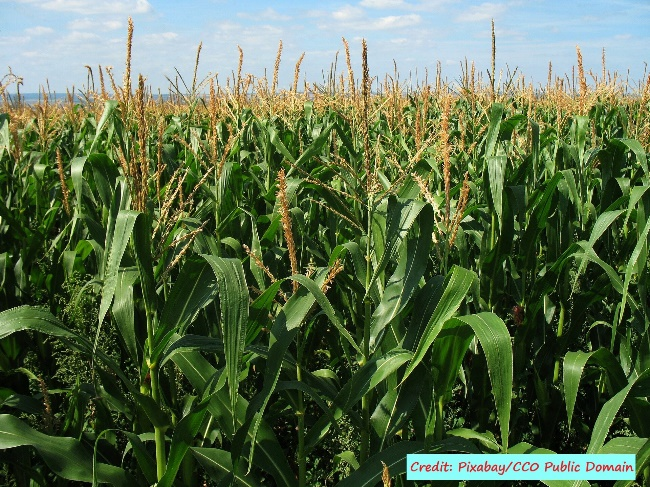 Although genetics research has been going on for over a century, the genetic basis of the excellent adaptability of maize to new environments is only just beginning to be understood. Recent studies from many labs have highlighted the potentially key role of introgression in adaptation; however, clear examples of adaptative loci are still lacking. Researchers at North Carolina State University, USA, led by Rubén Rellán-Álvarez at the Raleigh campus, show that an important corn gene called High PhosphatidylCholine 1 (HPC1) regulates certain chemical processes that contribute to flowering time; it is derived from “Teosinte mexicana,” a precursor to maize that grows wild in Mexico. The colder temperatures in the Mexican mountains put maize at a slight disadvantage, compared to maize grown at lower altitudes and higher temperatures, as they take a longer time to accumulate heat units for unit growth.
Although genetics research has been going on for over a century, the genetic basis of the excellent adaptability of maize to new environments is only just beginning to be understood. Recent studies from many labs have highlighted the potentially key role of introgression in adaptation; however, clear examples of adaptative loci are still lacking. Researchers at North Carolina State University, USA, led by Rubén Rellán-Álvarez at the Raleigh campus, show that an important corn gene called High PhosphatidylCholine 1 (HPC1) regulates certain chemical processes that contribute to flowering time; it is derived from “Teosinte mexicana,” a precursor to maize that grows wild in Mexico. The colder temperatures in the Mexican mountains put maize at a slight disadvantage, compared to maize grown at lower altitudes and higher temperatures, as they take a longer time to accumulate heat units for unit growth.
Native Americans domesticated corn thousands of years ago in the southwest from a wild plant known as Teosinte parviglumis, and with great ingenuity brought corn and adapted it across the Americas, from the deserts of Arizona and Peru to the rainforests of Yucatán and Colombia, including the highlands of Mexico, where maize was crossed with another wild teosinte plant, teosinte mexicana. “Our results indicate a corn mix and teosinte mexicana helped adapt corn to upland conditions and this blend is suitable for modern maize,” said Rellán-Álvarez. Researchers trace the evolutionary history of a major metabolic quantitative trait locus (QTL) that was mapped down to a single gene, HPC1. Alterations in highland HPC1 are the result of a teosinte mexicana introgression in maize, leading to high phosphatidylcholine levels and improving fitness by accelerating flowering. These results may have value in understanding the level of adaptation in other crop species, especially so considering the urgency of more information on adaption/adaptability to meet the demands placed by climate change and global warming,
Access the abstract at https://www.pnas.org/doi/abs/10.1073/pnas.2100036119
9. Designing roots to penetrate hard soils could help climate-proof crops
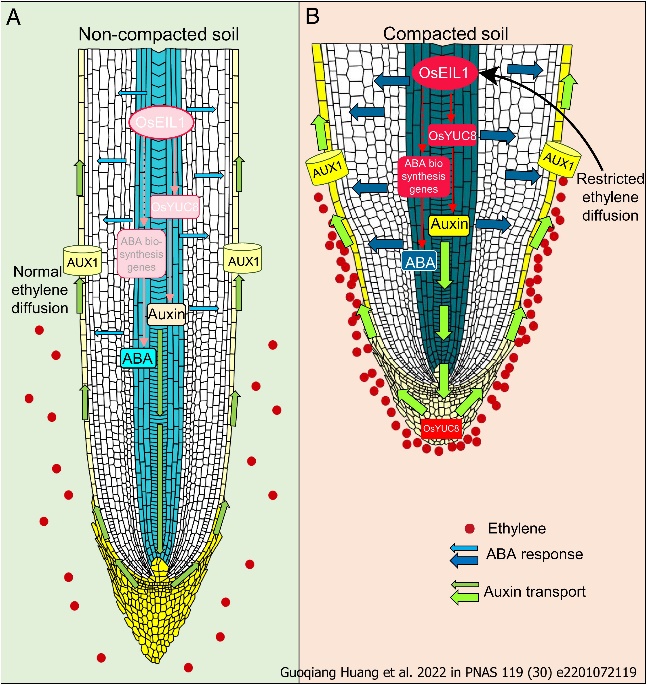 Intensive agriculture and changing tillage practices are causing soils to become increasingly compacted. Hard soils cause roots to accumulate the hormone ethylene, triggering reduced root elongation and increased radial swelling. An international team of scientists, led by Bipin Pandey at the University of Nottingham, UK, have discovered how engineered cereal roots (using rice and Arabidopsis mutants) can continue to grow in hard soil by altering their ability to penetrate, allowing the roots to access water deeper in the soil, thus helping “climate-resistance,” important in dealing with precipitation variability. They have discovered key genes, hormonal signals, and processes in rice roots that control their ability to penetrate even the hard soil.
Intensive agriculture and changing tillage practices are causing soils to become increasingly compacted. Hard soils cause roots to accumulate the hormone ethylene, triggering reduced root elongation and increased radial swelling. An international team of scientists, led by Bipin Pandey at the University of Nottingham, UK, have discovered how engineered cereal roots (using rice and Arabidopsis mutants) can continue to grow in hard soil by altering their ability to penetrate, allowing the roots to access water deeper in the soil, thus helping “climate-resistance,” important in dealing with precipitation variability. They have discovered key genes, hormonal signals, and processes in rice roots that control their ability to penetrate even the hard soil.
They report that hard soil causes roots to shorten and enlarge. Root swelling was originally thought to help penetrate hard ground. X-ray images of plants growing in soil in Nottingham have shown that still narrow roots penetrate hard soil more easily. The combined growth responses to auxin and abscisic acid (ABA) function to reduce the ability of roots to penetrate compacted soil. The study overturns decades of scientific thought, revealing that root swelling does not help penetrate the soil. The researchers conclude that ethylene uses auxin and ABA as downstream signals to modify rice root cell elongation and radial expansion, causing root tips to swell and reducing their ability to penetrate compacted soil. These findings could preserve or increase crop yields worldwide, especially since climate change may exacerbate soil resilience owing to reduced rainfall.
Access the full paper at https://www.pnas.org/doi/full/10.1073/pnas.2201072119
Potential Crops/Technologies/Concepts
1. Long-term study shows how climate-friendly practices could increase crop yields and improve farm ecosystems
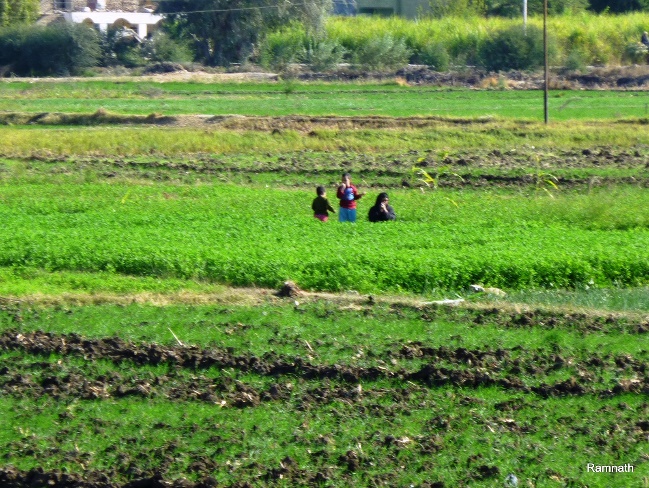 There is little doubt that we need to redesign agricultural landscapes to maintain their productivity and profitability while safeguarding and promoting biodiversity, regenerating the ecological processes that sustain food production, and thus keep this planet liveable. Ecological intensification (EI), i.e., using natural processes to replace human-produced inputs like pesticides and fertilizers while maintaining or increasing food production per unit area, could help return agriculture into a ‘safe operating space for humanity (see https://pubmed.ncbi.nlm.nih.gov/23153724/). An international team of researchers, led by Chloe MacLaren of the Stellenbosch University, Matieland, South Africa, conducted a long-term study and found that climate-smart farming methods can lead to increased crop yields, reduced costs, and improved local ecosystems. The study was based on 30 long-term agricultural experiments designed to improve agricultural practices in Europe and Africa.
There is little doubt that we need to redesign agricultural landscapes to maintain their productivity and profitability while safeguarding and promoting biodiversity, regenerating the ecological processes that sustain food production, and thus keep this planet liveable. Ecological intensification (EI), i.e., using natural processes to replace human-produced inputs like pesticides and fertilizers while maintaining or increasing food production per unit area, could help return agriculture into a ‘safe operating space for humanity (see https://pubmed.ncbi.nlm.nih.gov/23153724/). An international team of researchers, led by Chloe MacLaren of the Stellenbosch University, Matieland, South Africa, conducted a long-term study and found that climate-smart farming methods can lead to increased crop yields, reduced costs, and improved local ecosystems. The study was based on 30 long-term agricultural experiments designed to improve agricultural practices in Europe and Africa.
The researchers searched for alternative ways to grow food on a large scale by conducting multiple cropping experiments around the world to stabilize food production for farmers and consumers. During the nine-year study, the researchers grew maize, wheat, barley, oats, potatoes, and sugar beets, using different fertilization methods. Instead of just chemical fertilizers, as is done on modern large farms, they added plant matter, other composts, and manure. Specifically, the researchers found that they could increase yields by adding both manure and small amounts of chemical fertilizers. EI practices have a substitutive interaction with nitrogenous fertilizer, so EI practices increase yield at low N fertilizer doses but have minimal or no effect on yield at high N fertilizer doses. EI practices had comparable effects across different tillage intensities and reducing tillage did not strongly affect yields.
Access the abstract at https://www.nature.com/articles/s41893-022-00911-x
2. Wild tomato genome will benefit domesticated cousins
 Wild relatives of tomato are a valuable source of genes for tomato improvement, as plants tend to lose many genes over time when domesticated. Many tomato wild relatives can be hybridized with the cultivated species (Solanum lycopersicum). Several wild species, including S. lycopersicoides, have been crossed to cultivated tomatoes, facilitating breeding for desirable traits; however, very few genomes of these have been sequenced. A team of researchers led by Susan Strickler, Boyce Thompson Institute, Ithaca, New York, USA, and Björn Usadel, Aachen University, Germany, has assembled a reference genome for S. lycopersicoides, and developed online tools to help researchers and plant breeders. S. lycopersicoides contains a gene that makes plants resistant to specific bacterial spot diseases.
Wild relatives of tomato are a valuable source of genes for tomato improvement, as plants tend to lose many genes over time when domesticated. Many tomato wild relatives can be hybridized with the cultivated species (Solanum lycopersicum). Several wild species, including S. lycopersicoides, have been crossed to cultivated tomatoes, facilitating breeding for desirable traits; however, very few genomes of these have been sequenced. A team of researchers led by Susan Strickler, Boyce Thompson Institute, Ithaca, New York, USA, and Björn Usadel, Aachen University, Germany, has assembled a reference genome for S. lycopersicoides, and developed online tools to help researchers and plant breeders. S. lycopersicoides contains a gene that makes plants resistant to specific bacterial spot diseases.
In their study, the researchers demonstrated the value of the new genomics by finding several candidate genes associated with compounds—phenolics and carotenoids—that contribute to colour, flavour, and aroma, as well as other genes involved in disease resistance. They developed a tool—S. Lycopersicoides expression atlas—allowing users to analyse RNA sequence data and visualize which genes are expressed in different plant tissues and under different conditions. These tools, combined with the new reference genome, will make it easier for researchers to analyse wild and cultivated tomato crosses than in the past, and they will also help researchers study wild species themselves. Reference genomes can facilitate genome-wide association studies across multiple species to assess species genetic diversity and to identify candidate genes for traits that breeders may want to include in planted tomatoes, such as drought tolerance.
Access the full paper at https://onlinelibrary.wiley.com/doi/10.1111/tpj.15770
3. CRISPR-Combo combines gene activation and editing
 Since the discovery of CRISPR/Cas9 a decade ago, scientists have been able to change the genetic code of living organisms (AgriTech has been covering the developments in CRISPR technology for use in crop improvement: see AgriTech 41, 40,39, etc.); however, this first generation of technology could only remove or replace genes in a genetic sequence. Later versions can manipulate gene expression without the need to remove genes and further improvements are being made. In this process, CRISPR-Combo was developed by researchers at the University of Maryland College of Agriculture and Natural Resources, led by Yiping Qi, which can edit multiple genes, and change the expression of other genes in plants. The success rate of regenerating certain plants from tissue cultures is just 1%. The researchers have shown that the new method could offer a solution to the tissue regeneration bottleneck, dramatically increasing the efficiency of genetic engineering.
Since the discovery of CRISPR/Cas9 a decade ago, scientists have been able to change the genetic code of living organisms (AgriTech has been covering the developments in CRISPR technology for use in crop improvement: see AgriTech 41, 40,39, etc.); however, this first generation of technology could only remove or replace genes in a genetic sequence. Later versions can manipulate gene expression without the need to remove genes and further improvements are being made. In this process, CRISPR-Combo was developed by researchers at the University of Maryland College of Agriculture and Natural Resources, led by Yiping Qi, which can edit multiple genes, and change the expression of other genes in plants. The success rate of regenerating certain plants from tissue cultures is just 1%. The researchers have shown that the new method could offer a solution to the tissue regeneration bottleneck, dramatically increasing the efficiency of genetic engineering.
Meanwhile, the Chan Zuckerberg Initiative (CZI) plans to help the Innovative Genomics Institute (IGI) researchers at the University of California, Berkeley and Davis, and Lawrence Livermore National Laboratory (LLNL) to rapidly assess CRISPR gene editing in plants, primarily rice and sorghum, and hopefully get improved varieties into field trials in three to five years. CRISPR alone would be insufficient to accelerate plant breeding without a faster way to screen cells that have been edited —a high-throughput method to determine whether knocking out a gene or targeting a promoter to up- or down-regulate its associated gene has the desired effect. One key advantage of CRISPR is its ability to manipulate a plant’s genes to create new traits, as opposed to genetic modifications that get new breeds labelled as genetically modified organisms (GMO). For example, Krishna Niyogi, UC Berkeley, estimates that the suboptimal photosynthetic reactions in plants could be improved with CRISPR editing to be between 20% and 50% more efficient.
For more, see https://www.biotechniques.com/crispr/crispr-combo-combines-gene-activation-and-editing/ and https://www.universityofcalifornia.edu/news/10-years-crispr-transformed-medicine-can-it-now-help-us-deal-climate-change
Access the full paper at https://www.nature.com/articles/s41477-022-01151-9
4. Ecosystem restoration with DNA technology
 The monumental global task to restore degraded ecosystems will need to include sophisticated technologies, such as environmental DNA monitoring, to understand and support the recovery of complex biospheres, international researchers say. Genomics provides some important ‘weapons’ in the fight to repair ecosystems. Martin Breed and his colleagues from Flinders University, Bedford Park, Australia, investigated the role of genomic tools in the restoration of degraded ecosystems. They can tell us where the seeds/propagules are and which propagules have a better chance of surviving the effects of climate change, such as more frequent and intense heat waves. And genomics is the only way to track the return of soil microorganisms that support the rest of life on earth, plants, and animals. Genomics can be used to determine if endangered or undesirable species, such as invasive plants and animals, are returning from recovery efforts.
The monumental global task to restore degraded ecosystems will need to include sophisticated technologies, such as environmental DNA monitoring, to understand and support the recovery of complex biospheres, international researchers say. Genomics provides some important ‘weapons’ in the fight to repair ecosystems. Martin Breed and his colleagues from Flinders University, Bedford Park, Australia, investigated the role of genomic tools in the restoration of degraded ecosystems. They can tell us where the seeds/propagules are and which propagules have a better chance of surviving the effects of climate change, such as more frequent and intense heat waves. And genomics is the only way to track the return of soil microorganisms that support the rest of life on earth, plants, and animals. Genomics can be used to determine if endangered or undesirable species, such as invasive plants and animals, are returning from recovery efforts.
Greater adoption of genomics has a clear potential to advance the enormous task ahead, especially as declared by the United Nations Decade of Ecosystem Restoration, in support of the Bonn Challenge to restore 350 million hectares of ecosystems that will be degraded by 2030. The researchers provide a roadmap to facilitate the uptake of genomics into restoration, to help the restoration sector meet the monumental task of restoring huge areas to biodiverse and functional ecosystems. A roadmap that restoration ecologists’ have developed adds genomics to their toolbox and includes the need to improve communications in the field of restoration and genomics. The road map has immense potential in meeting the monumental task of restoring huge areas to biodiverse and functional ecosystems.
For more, see https://phys.org/news/2022-06-ecosystem-dna-technology.html?utm_source=nwletter&utm_medium=email&utm_campaign=daily-nwletter
Access the abstract at https://royalsocietypublishing.org/doi/10.1098/rstb.2021.0381
5. Breeding mung bean for the plant-based protein market
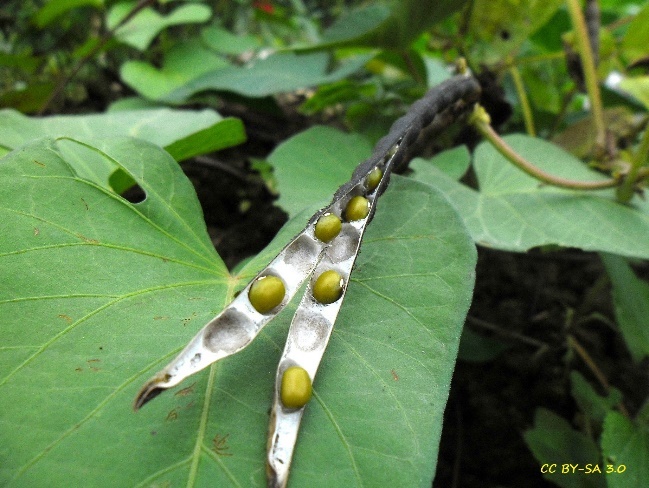 A common pulse crop, mung (Vigna radiata L.), a legume known for its drought tolerance and nitrogen-fixing ability, can be grown as a vegetable protein source. Mung beans are recognized for their high nutritive value; they contain about 55%-65% carbohydrate (equal to 630 g/kg dry weight) and are rich in protein, fat, vitamins, and minerals. Iowa State University researchers and plant breeders, led by Arti Singh, working collaboratively to develop a new crop to support the vegetable protein market, have identified mung beans as a good source of protein in burgers, high-protein pasta, cheeses, and snacks. In the United States, mung beans are widely sold as an egg substitute called “Just Egg”. The project will focus on breeding mung beans for plant protein production in an agronomically superior variety. “I wanted to assemble a strong group of scientists to form a coalition to support the growth of mung beans as a healthy and sustainable plant-based protein crop in the Midwest,” explains Singh. The team in charge of plant breeding will focus on creating new mung varieties with high protein content while using the new crosses by Singh. The other teams will work on evaluating crop management practices to help identify diseases, water stress tolerance, food-related traits, and insect-pest resistance.
A common pulse crop, mung (Vigna radiata L.), a legume known for its drought tolerance and nitrogen-fixing ability, can be grown as a vegetable protein source. Mung beans are recognized for their high nutritive value; they contain about 55%-65% carbohydrate (equal to 630 g/kg dry weight) and are rich in protein, fat, vitamins, and minerals. Iowa State University researchers and plant breeders, led by Arti Singh, working collaboratively to develop a new crop to support the vegetable protein market, have identified mung beans as a good source of protein in burgers, high-protein pasta, cheeses, and snacks. In the United States, mung beans are widely sold as an egg substitute called “Just Egg”. The project will focus on breeding mung beans for plant protein production in an agronomically superior variety. “I wanted to assemble a strong group of scientists to form a coalition to support the growth of mung beans as a healthy and sustainable plant-based protein crop in the Midwest,” explains Singh. The team in charge of plant breeding will focus on creating new mung varieties with high protein content while using the new crosses by Singh. The other teams will work on evaluating crop management practices to help identify diseases, water stress tolerance, food-related traits, and insect-pest resistance.
For more, see https://asiafoodjournal.com/breeding-mung-bean-plant-based-protein-market/
6. Towards a new design of sustainable cropping diversifications
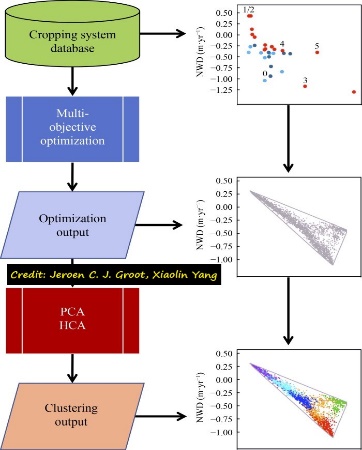 Since the Green Revolution, and with increased area under irrigation in many countries, there has been an increase in the use of fertilizers and pesticides to achieve high grain production for food security. A similar trend has been noted for a double cropping system with winter wheat and summer maize, which has dominated the North China Plain (NCP), resulting in the sharp depletion of groundwater and a series of environmental problems, such as water pollution. To achieve the several goals of high yield and good quality, as well as to reduce groundwater extraction, Jeroen Groot from Wageningen University, Netherlands, and Xiaolin Yang from China Agricultural University collaborated and developed a multi-objective optimal model, to generate a new configuration for 30 diverse types of crop systems practiced in NCP at the regional level, aimed at coordinating the balance between economic performance indicators, food security, and the environment.
Since the Green Revolution, and with increased area under irrigation in many countries, there has been an increase in the use of fertilizers and pesticides to achieve high grain production for food security. A similar trend has been noted for a double cropping system with winter wheat and summer maize, which has dominated the North China Plain (NCP), resulting in the sharp depletion of groundwater and a series of environmental problems, such as water pollution. To achieve the several goals of high yield and good quality, as well as to reduce groundwater extraction, Jeroen Groot from Wageningen University, Netherlands, and Xiaolin Yang from China Agricultural University collaborated and developed a multi-objective optimal model, to generate a new configuration for 30 diverse types of crop systems practiced in NCP at the regional level, aimed at coordinating the balance between economic performance indicators, food security, and the environment.
The differential evolutionary algorithm and the Pareto optimization model were used for multi-objective optimization to achieve reconfiguration of diverse crop systems with multi-objective and synergistic trade-offs. The researchers proposed solutions that optimized cropping patterns based on a diverse crop system, rather than a single crop area alone. China is a typical country for the use of many cropping systems, which improve the system’s yield by increasing the crop index. The authors conclude that a holistic analysis of the potential of a diversity of cropping systems at the regional level is needed to find integrative solutions for challenges from conflicting objectives for food production, economic viability, and environmental protection.
Access the full paper at https://journal.hep.com.cn/fase/EN/10.15302/J-FASE-2021434
News:
1. Market values are destroying nature: UN report
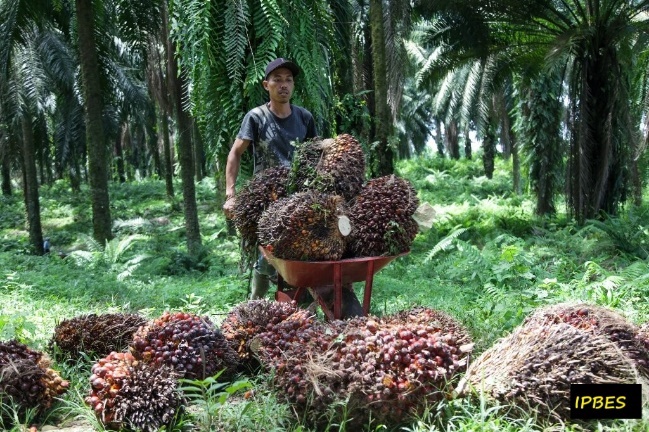 A recent United Nations (UN) report warned that the global economy’s focus on short-term profits is ruining the planet, and it called for a radically different approach to the way we value nature. About 80 experts have conducted more than 13,000 studies, looking at how market-based values contribute to the destruction of the ecosystems that sustain us and what other values can best promote sustainability.
A recent United Nations (UN) report warned that the global economy’s focus on short-term profits is ruining the planet, and it called for a radically different approach to the way we value nature. About 80 experts have conducted more than 13,000 studies, looking at how market-based values contribute to the destruction of the ecosystems that sustain us and what other values can best promote sustainability.
A 3-page summary was produced for policymakers, and it comes as the UN leads an international process to halt the loss of species and protect nature’s course. The report by The Intergovernmental Science-Policy Platform on Biodiversity and Ecosystem Services (IPBES) of the UN warns that this already daunting task of conserving species and protecting nature will become almost impossible unless humanity also changes the way it perceives and values nature. “”If you think of nature as a factory at your service, your emphasis will be on extracting the highest yields possible”,” said Patricia Balvanera, an ecologist at the National Autonomous University of Mexico and co-chair of the panel. More nuanced assessments can lead to better policy choices, the IPBES authors conclude. “If nature is part of me, part of my family, then just like in a family, the priority is to take care of each other,” says Balvanera.
For more, see https://phys.org/news/2022-07-values-nature.html?utm_source=nwletter&utm_medium=email&utm_campaign=daily-nwletter and
https://www.nature.com/articles/d41586-022-01930-6
2. Sustainable practices improve farmers’ well-being
 Smallholder farmers in rural areas of Tanzania can improve their food security and livelihoods by adopting nature-rich agricultural practices or agroecological practices, concludes a study by a team of researchers, led by Marion Pfeifer of the Newcastle University, Newcastle-upon-Tyne, UK. The research team surveyed 467 households in rural Tanzania and found that most farmers had adopted at least one nature-rich agricultural practice on their farms. The study also highlights the importance of basic technical training and capacity building for smallholder farmers to adopt sustainable, nature-rich, agricultural practices. Pfeifer said: “We show that activities that take advantage of Nature’s contributions to man in agricultural systems can positively contribute to the food security and human well-being of smallholder farmers in rural areas of the tropics. The findings help in formulating of policies relevant for land use and management, such as how to manage rural landscapes for biodiversity and well-being. Such change in agricultural practices could allow the increase or retain trees grown on and around farmland, adding not only climate change mitigation values but also opportunities for income generation. Results of this study could be useful in developing a policy and programme that ensures demand for food may be met sustainably without compromising the well-being of the world’s most vulnerable people, say the authors.
Smallholder farmers in rural areas of Tanzania can improve their food security and livelihoods by adopting nature-rich agricultural practices or agroecological practices, concludes a study by a team of researchers, led by Marion Pfeifer of the Newcastle University, Newcastle-upon-Tyne, UK. The research team surveyed 467 households in rural Tanzania and found that most farmers had adopted at least one nature-rich agricultural practice on their farms. The study also highlights the importance of basic technical training and capacity building for smallholder farmers to adopt sustainable, nature-rich, agricultural practices. Pfeifer said: “We show that activities that take advantage of Nature’s contributions to man in agricultural systems can positively contribute to the food security and human well-being of smallholder farmers in rural areas of the tropics. The findings help in formulating of policies relevant for land use and management, such as how to manage rural landscapes for biodiversity and well-being. Such change in agricultural practices could allow the increase or retain trees grown on and around farmland, adding not only climate change mitigation values but also opportunities for income generation. Results of this study could be useful in developing a policy and programme that ensures demand for food may be met sustainably without compromising the well-being of the world’s most vulnerable people, say the authors.
Access the full paper at https://link.springer.com/article/10.1007/s13593-022-00789-1
3. Using far less chemical fertilizer still produces high crop yields, study finds
 A study, led by Chloe MacLaren at the Rothamsted Research, Harpenden, UK, has shown for the first time that farmers can continue to produce high-yielding crops with less use of artificial fertilizers if they adopt environmentally friendly practices. According to the study, the adoption of these methods will be enough to replace a sizeable portion of chemical fertilizers, whose prices have skyrocketed owing to high fuel prices and the war in Ukraine. “Reducing reliance on chemical fertilizers will help protect farmers and consumers from economic shocks. Widespread adoption of these practices could also contribute to a more equitable global distribution of fertilizers,’’ MacLaren said. Scientists analysed 30 long-term experiments on farms in Europe and Africa to assess how natural farming methods could improve yields.
A study, led by Chloe MacLaren at the Rothamsted Research, Harpenden, UK, has shown for the first time that farmers can continue to produce high-yielding crops with less use of artificial fertilizers if they adopt environmentally friendly practices. According to the study, the adoption of these methods will be enough to replace a sizeable portion of chemical fertilizers, whose prices have skyrocketed owing to high fuel prices and the war in Ukraine. “Reducing reliance on chemical fertilizers will help protect farmers and consumers from economic shocks. Widespread adoption of these practices could also contribute to a more equitable global distribution of fertilizers,’’ MacLaren said. Scientists analysed 30 long-term experiments on farms in Europe and Africa to assess how natural farming methods could improve yields.
They found that the use of sustainable farming techniques did not increase yields when used in conjunction with heavy fertilization, at a scale commonly used in farming, but produced good yields especially when they are practiced with the addition of a little nitrogen to the soil. Fertilizer prices have in some cases more than tripled, partly due to soaring fuel prices as the world recovers from the economic shock of Covid-19, but skyrocketed owing to the war in Ukraine. Fertilizer abuse is a severe problem in developed countries, where farmers have become dependent on synthetic chemicals to feed their crops. In addition, ecological intensification practices had comparable effects across different tillage intensities and reducing tillage did not strongly affect yields.
For more, see https://www.theguardian.com/environment/2022/jun/27/using-far-less-chemical-fertiliser-still-produces-high-crop-yields-study
Access the abstract at https://www.nature.com/articles/s41893-022-00911-x
4. Growing vine plants hydroponically
 Grape leaves are considered a delicacy in the Mediterranean and the Middle East, but they can also be found in Asia, the Americas, and parts of Africa. Most of the leaves, are available, however, only as a by-product during the short harvest period, owing to viticulture practices and extensive chemical applications. Ioanna Chatzigeorgiou and colleagues from the Institute of Plant Breeding and Genetic Resources, ELGO-DIMITRA, Thessaloniki, Greece, studied the growing of vines hydroponically in a greenhouse (without pesticides) to prolong the cultivation period and at high planting densities, to maximize the yield of fresh leaves. Quantitative and qualitative characteristics, such as leaf number and weight, leaf colour, nitrate, photosynthetic parameters, total phenols, and phytonutrient concentrations were obtained, and the environmental impact of the product was calculated. The team produced very good quality leaves with a lower product carbon footprint compared to using 1.7p perlite as the substrate. The authors plan to evaluate the water as a substrate and nutrient retention along with year-round production in a heated greenhouse with full climate control, so that plants are kept evergreen.
Grape leaves are considered a delicacy in the Mediterranean and the Middle East, but they can also be found in Asia, the Americas, and parts of Africa. Most of the leaves, are available, however, only as a by-product during the short harvest period, owing to viticulture practices and extensive chemical applications. Ioanna Chatzigeorgiou and colleagues from the Institute of Plant Breeding and Genetic Resources, ELGO-DIMITRA, Thessaloniki, Greece, studied the growing of vines hydroponically in a greenhouse (without pesticides) to prolong the cultivation period and at high planting densities, to maximize the yield of fresh leaves. Quantitative and qualitative characteristics, such as leaf number and weight, leaf colour, nitrate, photosynthetic parameters, total phenols, and phytonutrient concentrations were obtained, and the environmental impact of the product was calculated. The team produced very good quality leaves with a lower product carbon footprint compared to using 1.7p perlite as the substrate. The authors plan to evaluate the water as a substrate and nutrient retention along with year-round production in a heated greenhouse with full climate control, so that plants are kept evergreen.
For more, see https://www.hortidaily.com/article/9443539/research-growing-vine-plants-hydroponically/
Access the full paper at https://www.mdpi.com/2071-1050/14/13/8011
5. Research targets underserved markets
 There are many communities of people who do not benefit from the fruits of agricultural research, either because of their remoteness or, as it happens more often, because they grow what have been called ‘orphan crops’ that receive little attention by researchers and/or by funders. A new dataset and analysis platform has been launched to ensure that plant breeders develop new plant varieties that benefit the world’s most disadvantaged people, by the Excellence in Breeding Platform of the Consultative Group on International Agricultural Research (CGIAR).
There are many communities of people who do not benefit from the fruits of agricultural research, either because of their remoteness or, as it happens more often, because they grow what have been called ‘orphan crops’ that receive little attention by researchers and/or by funders. A new dataset and analysis platform has been launched to ensure that plant breeders develop new plant varieties that benefit the world’s most disadvantaged people, by the Excellence in Breeding Platform of the Consultative Group on International Agricultural Research (CGIAR).
Researchers have identified about 142 breeding pipelines for 25 crops. The data will help identify underserved market segments and areas with overinvestment. “Too often public breeding has operated without a complete understanding of the market segments, their potential opportunities and impacts,” said Peter Coaldrake of the Platform. The new initiatives on Market Intelligence and Accelerated Breeding by the CGIAR will carry the work forward to sharpen investment decisions. The team will work with national research and extension services in Africa, Asia, and Latin America to help them use data to guide their programmes.
6. Conservation and sustainable use of global biodiversity more urgent than ever, calling for effective governance, say experts
Biodiversity loss continues unabated. Despite an impressive array of international law and policy instruments, biodiversity governance efforts have hardly been impressive in supporting the conservation, as well as sustainable and equitable use, of biodiversity. The need for transformative change has been well-recognized, but it has hardly been followed up. A recent book (see link for details) reviews the state-of-the-art knowledge on transformative biodiversity governance and explores its practical implications in various contexts and issues relevant for the long-term biodiversity policy agenda. Applying the book’s transition governance framework to further exploit the transformative potential of some of the governance arrangements proposed, it argues that biodiversity governance can contribute to sustainable, eco-cantered, compassionate, and equitable development.
Biodiversity governance becomes more urgent as the world faces the greater threat of almost a million plant and animal species becoming extinct in the coming decades, which seriously endangers life as we know it, reports IPBES (Intergovernmental Science-Policy Platform On Biodiversity And Ecosystem Service of the UN). Soil degradation has reduced crop yields by about 23%, amounting to annual global crop losses of US$577 billion, exacerbated by the loss of pollinators. Around 100-300 million people have an increased risk of floods and storms, owing to the loss of coastal areas as habitat protection is lost. Plastic pollution has increased tenfold since 1980; 300 to 400 million tonnes of heavy metals, solvents, toxic sludge, and other wastes from industrial facilities are dumped into the world’s seas each year, and fertilizers entering coastal ecosystems have created more than 400 ‘ocean dead zones’, a total area of more than 245,000 km2. Changing the global economic and financial system to build a sustainable global economy, away from the current restrictive economic growth model, is also identified as a key element of future policies, and thus a more sustainable future. “We thank the hundreds of experts around the world who have given their time and knowledge to help address the loss of species, ecosystems and genetic diversity—a threat to global and generational people,” says IPBES.
For more, see https://sdg.iisd.org/commentary/guest-articles/the-urgency-of-transforming-biodiversity-governance/ and https://www.cbd.int/gbo5 and https://ipbes.net/global-assessment and https://www.eurekalert.org/news-releases/958195 and https://ipbes.net/global-assessment
7. Removing the nitrogen bottleneck in the world’s food supply
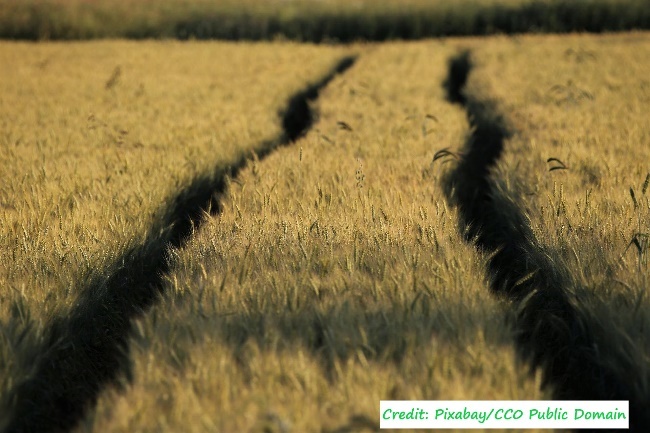 Nitrogen is the most important nutrient, and plants absorb more nitrogen than any other element. Nitrogen is essential in ensuring that plants are healthy as they develop and nutritious to eat after they are harvested. It is also the most important plant nutrient that has been polluting rivers and oceans. Hence, we need to limit its use, but at the same time harvest enough crops to meet world food and other needs. Researcher Yasuhiro Ohki and colleagues from the University of Hawaii at Mānoa have developed a synthetic method to convert nitrogen into a bioavailable form, which could enable the production of ammonia fertilizers at a much lower cost and lead to greater food production worldwide. The results of the research exemplify the catalytic silylation of N2 by a synthetic metal–sulphur cluster and demonstrate the N2-reduction capability of Fe atoms in a sulphur-rich environment, which is reminiscent of the ability of FeMoco to bind and activate N2. Although nitrogen is not depleted in the atmosphere, scientists say that making enough bioavailable forms of nitrogen remains one of the most important bottlenecks in Earth’s ecosystems. “This study is a major step towards removing the nitrogen bottleneck for the global food supply,” said Roger Cramer, a co-author.
Nitrogen is the most important nutrient, and plants absorb more nitrogen than any other element. Nitrogen is essential in ensuring that plants are healthy as they develop and nutritious to eat after they are harvested. It is also the most important plant nutrient that has been polluting rivers and oceans. Hence, we need to limit its use, but at the same time harvest enough crops to meet world food and other needs. Researcher Yasuhiro Ohki and colleagues from the University of Hawaii at Mānoa have developed a synthetic method to convert nitrogen into a bioavailable form, which could enable the production of ammonia fertilizers at a much lower cost and lead to greater food production worldwide. The results of the research exemplify the catalytic silylation of N2 by a synthetic metal–sulphur cluster and demonstrate the N2-reduction capability of Fe atoms in a sulphur-rich environment, which is reminiscent of the ability of FeMoco to bind and activate N2. Although nitrogen is not depleted in the atmosphere, scientists say that making enough bioavailable forms of nitrogen remains one of the most important bottlenecks in Earth’s ecosystems. “This study is a major step towards removing the nitrogen bottleneck for the global food supply,” said Roger Cramer, a co-author.
Access the abstract at https://www.nature.com/articles/s41586-022-04848-1
8. A climate-smart remodelling of South Asia’s rice-wheat cropping is urgently needed
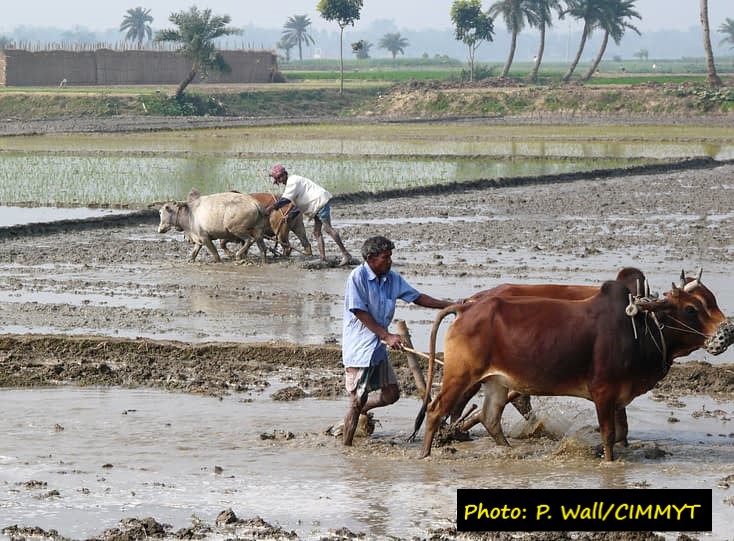 As a climate change hotspot that includes both small-scale and intensive agriculture, South Asia epitomizes the overwhelming pressure placed on available land and water resources for agriculture. For example, the continuously irrigated rice and wheat farming in northern India depletes and degrades the soil, drains aquifers, and produces a considerable amount of greenhouse gases.
As a climate change hotspot that includes both small-scale and intensive agriculture, South Asia epitomizes the overwhelming pressure placed on available land and water resources for agriculture. For example, the continuously irrigated rice and wheat farming in northern India depletes and degrades the soil, drains aquifers, and produces a considerable amount of greenhouse gases.
Through decades of research by global and Asian partnerships, the International Maize, and Wheat Improvement Center (CIMMYT) engages in assisting research and advancing climate-smart and resource-saving solutions for agriculture in South Asia. A recent study examines the potential of a range of improvement measures—such as reduced tillage or no tillage with residue management, use of organic fertilizers, balanced fertilization, and the synthesis of nutrients, phytonutrients, soil levelling, precision water, and pest control—to capture and retain carbon in the soils of small-scale farms in South Asia. The study of soil quality found that conservation agricultural practices increased wheat yields per hectare by almost half a tonne and improved soil quality by almost a third, compared with conventional methods, in addition to reducing greenhouse gas emissions by >60%.
For more, see https://www.cimmyt.org/news/a-climate-smart-remodeling-of-south-asias-rice-wheat-cropping-is-urgent/
9, Cotton breeders use genetic insights to make the global crop more sustainable
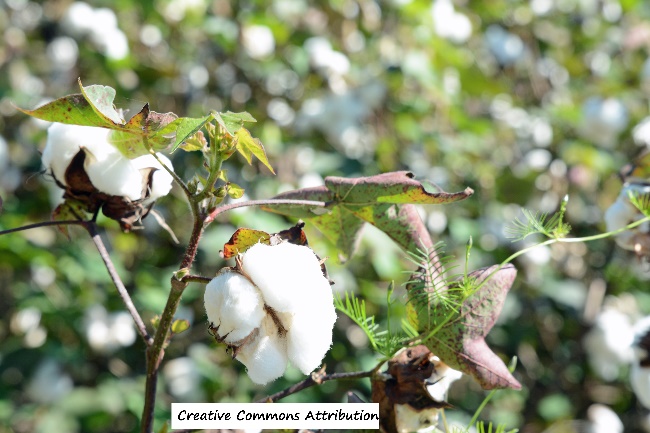 Products derived from the cotton plant show up in many items that people use daily, including blue jeans, bedsheets, paper, candles, and peanut butter. In the United States, cotton is an annual crop worth US$7 billion, grown in 17 states from Virginia to Southern California. Today, however, it is at risk. Cotton plants from fields in India, China, and the United States—the world’s top three producers—all grow, flower, and produce cotton in similar ways. In a perfect world, scientists could modify several key components of the cotton genome to make the crop more resistant to stresses such as pests, bacteria, fungi, and drought, says Serina Taluja of the Texas A&M University, USA.
Products derived from the cotton plant show up in many items that people use daily, including blue jeans, bedsheets, paper, candles, and peanut butter. In the United States, cotton is an annual crop worth US$7 billion, grown in 17 states from Virginia to Southern California. Today, however, it is at risk. Cotton plants from fields in India, China, and the United States—the world’s top three producers—all grow, flower, and produce cotton in similar ways. In a perfect world, scientists could modify several key components of the cotton genome to make the crop more resistant to stresses such as pests, bacteria, fungi, and drought, says Serina Taluja of the Texas A&M University, USA.
The collection of wild genomes makes it possible for researchers to begin using their valuable genes to try and improve cultivated cotton varieties, by crossing them and looking for these genes in the progeny. Identifying which parts of the genome a parent has can give breeders a better idea of which plants to cross and then produce better and more productive cotton with each generation. Making cotton more productive is not the only goal of genetic improvement. Cotton is already a heat-accustomed crop—but it is water-intensive crop, needing about 20,000 litres of water to produce a kilogram of usable cotton. Along with the work of many other cotton breeders around the world, the goal of Taluja’s work is to create more sustainable and genetically diverse cotton, so that this essential crop can thrive in a changing world.
For more, see https://theconversation.com/cotton-breeders-are-using-genetic-insights-to-make-this-global-crop-more-sustainable-185284
10. Drought has clear impacts on global agricultural production
 Globally, maize, rice, soybean, and wheat are key crops in the debate about the production of food on available land, using water, energy. and other resources sustainably. The debate on human consumption vs. animal feed, and about the environmental footprints owing to land and water exploitation and greenhouse gas emissions by these crops, add to the issues related to sustainable and healthy diets. The same crops represent biomass-energy sources as well, the key to meeting the mitigation targets from the Paris Agreement. While compelling evidence exists on the effects of climate variability on the production of these crops, so far, the many attributes of droughts—such as magnitude, frequency, duration, and timing—have mostly been dealt with separately, and that too for a limited part of the cropping season, or over small regions.
Globally, maize, rice, soybean, and wheat are key crops in the debate about the production of food on available land, using water, energy. and other resources sustainably. The debate on human consumption vs. animal feed, and about the environmental footprints owing to land and water exploitation and greenhouse gas emissions by these crops, add to the issues related to sustainable and healthy diets. The same crops represent biomass-energy sources as well, the key to meeting the mitigation targets from the Paris Agreement. While compelling evidence exists on the effects of climate variability on the production of these crops, so far, the many attributes of droughts—such as magnitude, frequency, duration, and timing—have mostly been dealt with separately, and that too for a limited part of the cropping season, or over small regions.
A study, led by Monia Santini of the Foundation Euro-Mediterranean Center on Climate Change (CMCC), Viterbo, Italy, conducted a comprehensive assessment and showed how droughts with their complex patterns—given by their compound attributes—consistently had negative impacts on crop yield on a global scale. Researchers analysed the magnitude and frequency of both climate and yield variability from 1981 to 2016, considering multiscale droughts, i.e., dry conditions occurring with different durations and timings along the whole farming season, through two analogous and standardized indicators, enabling comparison among crops, countries, and years. The results of this study show how the yield of the crops analysed is susceptible to droughts and that such a complex drought-low yield connection is a consistent feature on a global scale. “Overall, our comprehensive analysis could add valuable information to deal, in a harmonized way, with drought impacts on the global agricultural production for multipurpose crops,” Santini concludes.
Access the full paper at https://www.nature.com/articles/s41598-022-09611-0
Events (February 2023):
1. ICABS International Conference on Agricultural and Biological Science

02-03 Feb 2023, Putrajaya, Malaysia
For more, see http://iser.co/Conference2023/Malaysia/1/ICABS/
2. ICEA International Conference on Ecological Agriculture
06-07 Feb 2023, Lisbon, Portugal 
For more, see https://waset.org/ecological-agriculture-conference-in-february-2023-in-lisbon
3. ICAB International Conference on Agriculture and Biotechnology
06-07 Feb 2023, Melbourne, Australia 
For more, see https://waset.org/agriculture-and-biotechnology-conference-in-february-2023-in-melbourne
4. ICPBA International Conference on Plant Breeding and Agriculture
06-07 2023 Amsterdam, Netherlands 
For more, see https://waset.org/plant-breeding-and-agriculture-conference-in-february-2023-in-amsterdam
5. ICAPF International Conference on Agriculture and Precision Farming
20-21 Feb 2023, Jeddah, Saudi Arabia 
For more, see https://waset.org/agriculture-and-precision-farming-conference-in-february-2023-in-jeddah
Other Topics of Interest
1. Lupin used as winter cover crop boosts summer sorghum yield
Access the full paper at https://acsess.onlinelibrary.wiley.com/doi/10.1002/agj2.21018
2. Botanists are disappearing—just when the world needs them most
For more, see https://theconversation.com/botanists-are-disappearing-just-when-the-world-needs-them-most-186849
3. How does nematode infection activate plant defence response in soybean plants?
Access the full paper at https://www.frontiersin.org/articles/10.3389/fpls.2022.866322/full
4. Biodiversity risks to persist well beyond future global temperature peak
Access the full paper at https://royalsocietypublishing.org/doi/10.1098/rstb.2021.0394
5. Examining the trait-dependent demographic costs of reproduction in coexisting plant species
Access the abstract at https://besjournals.onlinelibrary.wiley.com/doi/10.1111/1365-2745.13951
6. Mechanism for chloroplast protein translocation and quality control
Access the full paper https://academic.oup.com/plcell/advance-article/doi/10.1093/plcell/koac180/6609184?login=false
7. Crop protection: Biohacking against fungal attacks
For more, see https://phys.org/news/2022-07-crop-biohacking-fungal.html?utm_source=nwletter&utm_medium=email&utm_campaign=daily-nwletter
8. How not to solve the climate change problem?
For more, see https://phys.org/news/2022-07-climate-problem.html?utm_source=nwletter&utm_medium=email&utm_campaign=daily-nwletter
9. People-powered research and experiential learning: Unravelling hidden biodiversity
Access the full paper at https://riojournal.com/article/83853/
10. Helping nature help us—Transforming disaster risk reduction through ecosystem management
For more, see https://portals.iucn.org/library/sites/library/files/documents/2016-070.pdf
11. Geoengineering carries ‘large risks’ for the natural world, studies show
For more, see https://www.carbonbrief.org/geoengineering-carries-large-risks-for-natural-world-studies-show/?ref=refind
12. Breeding with ‘wild relatives’ to produce disease and climate resistant wheat
Access the full paper (1) at https://www.frontiersin.org/articles/10.3389/fpls.2022.919519/full
Access the full paper (2) at https://www.frontiersin.org/articles/10.3389/fpls.2022.943211/full
13. Sustainable practices linked to farm size in organic farming
Access the abstract at https://www.nature.com/articles/s41477-022-01191-1n
14. Logging is destroying southern forests—and dividing US environmentalists
For more, see https://grist.org/energy/logging-biomass-nature-conservancy/?ref=refind
15. Dubai unveils the world’s largest indoor farm that will produce 2 million pounds of leafy greens yearly
For more, see https://www.zmescience.com/science/dubai-largest-indoor-farm-26363452/
16. By 2050, there will be 10 billion people to feed. To meet the challenge, we need all technologies on deck—including molecular biology and genetic engineering
17. A history of rye: How early farmers made plants genetically less flexible
For more, see https://www.eurekalert.org/news-releases/959394
18. Food expiration dates do not have much science behind them—a food safety researcher explains another way to know what is too old to eat
19. The sweet discoveries of the sweet corn hybrid
Access the full paper at https://www.frontiersin.org/articles/10.3389/fpls.2021.707852/full
20. Plant study hints evolution may be predictable
For more, see https://phys.org/news/2022-07-hints-evolution.html?utm_source=nwletter&utm_medium=email&utm_campaign=daily-nwletter
Access the abstract at https://www.nature.com/articles/s41559-022-01823-x
21. Reshuffled rivers bolster the Amazon’s hyper-biodiversity
For more, see https://www.quantamagazine.org/reshuffled-rivers-bolster-the-amazons-hyper-biodiversity-20220607?ref=refind
22. ‘Soil Isn’t Forever’: Why biodiversity also needs protection below the ground
For more, see https://www.resilience.org/stories/2022-07-14/soil-isnt-forever-why-biodiversity-also-needs-protection-below-the-ground/
23. Pilot program builds a better seaweed supply chain
For more, see https://foodtank.com/news/2022/06/pilot-program-builds-a-better-seaweed-supply-chain/
24. Six guiding principles for the EU agricultural policy to halt biodiversity loss
Access the full paper at https://conbio.onlinelibrary.wiley.com/doi/10.1111/conl.12901
25. Can we feed the world on marginal land??
For more, see https://saifood.ca/feed-world-marginal-land/
26. Scaling new heights with new research showing how plants can grow at altitude
For more, see https://phys.org/news/2022-06-scaling-heights-altitude.html?utm_source=nwletter&utm_medium=email&utm_campaign=daily-nwletter
Access the full paper at https://www.nature.com/articles/s41586-022-04740-y
27. Largest plant on Earth is 4,500 years old: A 180 km seagrass field found to be one immense clonal plant
Access the full paper at https://royalsocietypublishing.org/doi/10.1098/rspb.2022.0538
28. Invasive alien species threat to Kenya
29. Scientists unravel mechanism for melting of DNA double helix
Access the full paper at https://www.nature.com/articles/s41586-022-04829-4
30. Exploring how plants colonized land half a billion years ago
Access the full paper at https://www.cell.com/trends/plant-science/fulltext/S1360-1385(22)00143-1?_returnURL=https%3A%2F%2Flinkinghub.elsevier.com%2Fretrieve%2Fpii%2FS1360138522001431%3Fshowall%3Dtrue
31. Timing is everything for weed management
For more, see https://phys.org/news/2022-06-weed.html?utm_source=nwletter&utm_medium=email&utm_campaign=daily-nwletter
Access the full paper at https://www.frontiersin.org/articles/10.3389/fagro.2022.888664/full
32. A quest to digitize 1 million plant specimens
33. Aquaculture drives aquatic food yields to new high
34. How changing your diet can help fight the climate crisis
For more, see https://phys.org/news/2022-07-diet-climate-crisis.html?utm_source=nwletter&utm_medium=email&utm_campaign=daily-nwletter
35. ‘Win-win for food security’—Why Uganda needs both biotechnology and agroecology to feed itself as climate change roils farming
Sustainable practices improve farmers’ well-being
Access the full paper at https://link.springer.com/article/10.1007/s13593-022-00789 -1
36. Hidden in plain sight: Seven new species of showy tropical forest ferns
37. How artificial intelligence is boosting crop yield to feed the world
For more, see https://www.freethink.com/technology/boosting-crop-yield
38. Keeping our options open
39. Research team classifies key gene for cell division for the first time
For more, see https://phys.org/news/2022-07-team-key-gene-cell-division.html
Access the abstract at https://academic.oup.com/mbe/article/39/6/msac123/6603878?login=false
40. ‘Optimizing nature’—How gene editing can help grow crops in unstable climates using less water
41. Interactive database of genome editing applications in crops and future policy making in the European Union
For more, see https://www.cell.com/trends/plant-science/fulltext/S1360-1385(22)00140-6?dgcid=raven_jbs_etoc_email
42. Ensuring positive impacts on biodiversity under the future CAP: proposals by more than 300 experts from 23 EU Member States
For more, see https://www.eurekalert.org/news-releases/957532
Access the full paper at https://conbio.onlinelibrary.wiley.com/doi/10.1111/conl.12901
43. The secret to tastier fake meat? Breeding better beans
for more, see https://www.wired.co.uk/article/meat-substitutes-breeding-better-beans
44. Junk food is bad for plants, too
For more, see https://worldsensorium.com/junk-food-is-bad-for-plants-too/
45. Ecological restoration priorities must be informed by marginalized people
Access the abstract at https://www.nature.com/articles/s41586-020-2784-9
46. The sea-island cotton GbTCP4 transcription factor positively regulates drought and salt stress responses
For more, see https://www.isaaa.org/kc/cropbiotechupdate/article/default.asp?ID=19562
Access the abstract at https://www.sciencedirect.com/science/article/abs/pii/S0168945222001534
47. Biodiversity survey reveals that more species are threatened with extinction than previously thought
For more, see https://www.eurekalert.org/news-releases/959052
Access the full paper at
https://esajournals.onlinelibrary.wiley.com/doi/10.1002/fee.2536
48. Weather extremes to change future farming
Access the full paper at https://www.tandfonline.com/doi/full/10.1080/21681376.2022.2074307?cookieSet=1
49. A researcher from Diverfarming measuring soil organic carbon in soils.
Access the full paper at https://www.frontiersin.org/articles/10.3389/fenvs.2022.819162/full
50. Scientists find DNA from 1,200 different insect species in tea. Here is why that is actually a good sign
Access the full paper at https://royalsocietypublishing.org/doi/10.1098/rsbl.2022.0091
51. Discovery of unique protein brings us a step closer to insect-resistant crops
Access the full paper at https://www.cell.com/cell-reports/fulltext/S2211-1247(21)01621-1?_returnURL=https%3A%2F%2Flinkinghub.elsevier.com%2Fretrieve%2Fpii%2FS2211124721016211%3Fshowall%3Dtrue
